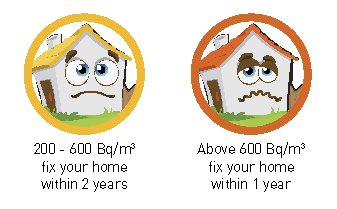
How Do I Test My Home For Radon?
The do's and don'ts of radon test placement, type and what to look for when you receive your results.
- by kristin
Perhaps you've been exploring our site, a friend mentioned you should look into it or you've been meaning to get it done for ages and just haven't yet found the time, whatever your reason - it's time to test for radon.
Getting Started:
Let's establish some basics - let's enter Kristin's Choose Your Own Radon Test Adventure. Buckle up, friends.

So we know what kind of test we're working with...but where to place it?
- The lowest lived-in level of the home. I know that direction sounds clumsy but the intent is to test the highest potential level for radon entry. Closer to the ground usually means a higher potential for radon. If you don't go into your basement except to store boxes, move to the next floor up. Health Canada defines "lived-in" as an average of 4 hours per day or more. If you have plans on developing your basement, use it for a gym (rapid breathing), a children's play area or have plans to in the future you may also want to consider testing here.
- Regular breathing space. Think about where you typically spend your time - and take up space. Place or hang your detector (either is perfectly fine) at least a few feet up from the ground and away from the ceiling. A bookshelf, night stand, shelf or chair are all great locations.
- Do not place it - in a bathroom, in a kitchen, in the mechanical room, in a hallway, near windows or doors or in close proximity to a sump pit.
Now we wait. Health Canada recommends testing for a minimum of 90 days up to a year in duration. It was previously thought that testing should only be completed over winter heating months as this was believed to be when higher radon concentrations typically presented, but research from Evict Radon - check out our link or info in Publications - has determined that this is not always the case. Aim to test over a variety of seasonal and weather conditions to determine your average exposure.
The Numbers - You've received your test results or been logging all along with a digital monitor, what number should you be watching out for? Current Health Canada guidance recommends mitigation action for homes determined as over 200 Bq/m3 within 2 years, and within 1 year for homes determined as over 600 Bq/m3. Some chose to mitigate even lower, following guidance from the World Health Organization with a lower guidance limit of 100 Bq/m3 or the Environmental Protection Agency at 148 Bq/m3. For more information on testing guidelines and levels visit our Radon Testing, Current Guidelines and Research pages.
